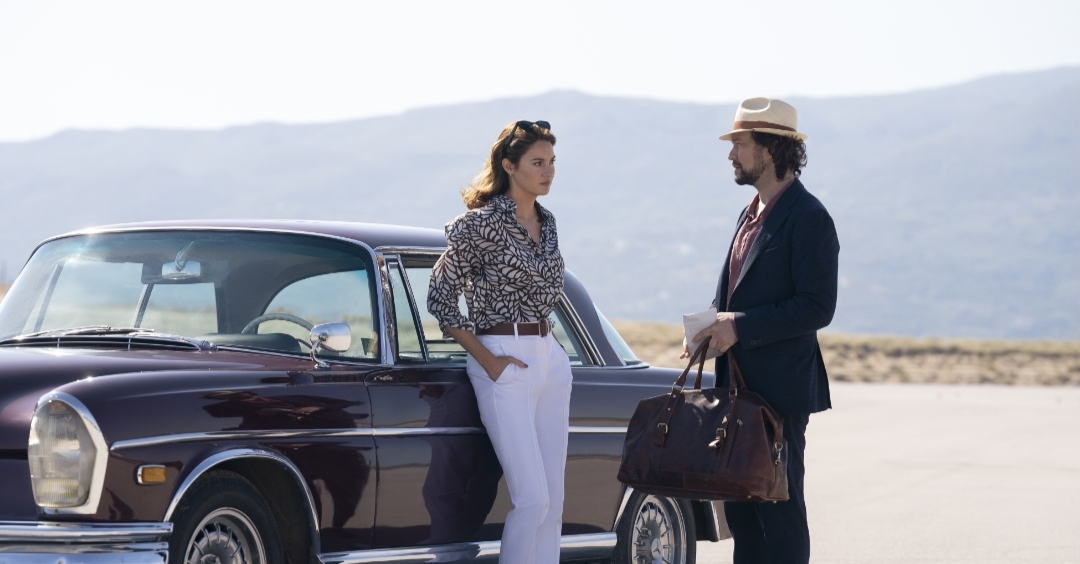In Prime Video’s ‘Killer Heat,’ the picturesque island of Crete turns into the site of a murder investigation when Leo Vardakis falls to his death while climbing a cliff. While it seems like an accident, some people are convinced that Leo was murdered. One of those people is Penelope, the wife of Leo’s twin, Elias. She thinks that there is some foul play involved in the death of her brother-in-law, who she may or may not have had an affair with. She calls private investigator, Nick Bali, to solve the case. While he has no connection to the victim or the suspects, the deeper he gets into the investigation, the more he seems to reflect on his own actions. Directed by Philippe Lacôte, the 2024 film humanizes his character, making him more interesting and compelling. The reason behind it being so realistic lies in the inception of the story.
Killer Heat Adapts a Fictional Story by a Celebrated Author

‘Killer Heat’ is an entirely fictional tale which adapts the titular short story from author Jo Nesbo’s 2021 book, ‘The Jealousy Man and Other Stories.’ The celebrated crime author usually writes full length novels, but this is one of the rare times he ventured into the field of short story writing. The idea for the collection came with ‘The Jealousy Man,’ which is heavily infused with the complicated emotion of jealousy. Nesbo revealed that when he started working on the story, he himself had been working through a fit of jealousy, though he didn’t elaborate more on his personal situation at the time. Reflecting on his feelings, Nesbo saw how interesting an emotion jealousy was, how removed from anger and yet just as destructive. He also saw jealousy as being quite close to love, but completely flipping the emotion, which becomes tainted with darkness.
While the idea was still brewing in his head, Nesbo was also enjoying the sport of climbing, which is when the initial setup for the story came to his mind. The image of a man falling to his death while climbing a cliff stuck in his mind, and from there, he expanded the story into what eventually turned out to be ‘The Jealousy Man.’ Nesbo stated that even as he was constructing the plot and the structure of the story in his head, he knew that this one needed to have the punch of emotion. Talking about his approach for murder mysteries, the writer said that he often returns to feelings like jealousy as they provide a strong motive to kill someone. Still, it needed to be explainable in a way that would make the killer justify his/her own actions.

Just as working the case makes Nick Bali reflect on his own life, Nesbo too used the story to process his own feelings. He tapped into his own emotions to let them out on paper, but even as he wrote, he could see a deeper layer in the feeling of jealousy, which is what he tried to get to with the story, even though it remains entirely fictional.
Joseph Gordon Levitt Leaned Into the Complexities of Nick Bali
Nesbo’s ‘The Jealousy Man’ is adapted for the screen by Roberto Bentivegna and Matt Charman, who added a fresh twist to the story. For starters, the setting, while keeping it in the original location of Crete, was Americanized. This turned the original character, Nikos Balli, into Nick Bali. The writers fleshed out several parts of the short story to give more edge to the film. However, their intention was to remain true to the source material as much as possible. When Joseph Gordon Levitt was brought on board, he brought his own sensibility to the character.

Levitt noted that the hallmark of any good murder mystery is its characters, and he tried to make Bali as realistic and relatable as possible. He identified with Bali’s struggles and dug into his psyche to understand what makes the character tick. He was also motivated by the fact that he wanted Nick to come out at the end with a significant development in his character. The experience had to change him, but for that the audience needed to know who he was and what his journey before his arrival in Crete entailed. Citing directors like Rian Johnson, who often focus more on the characters than the plot, Levitt brought a depth to Bali which grounded him in reality to make the audience empathize with him, giving him a more realistic touch.
Read More: Killer Heat Ending, Explained: Who is the Killer?


You must be logged in to post a comment.